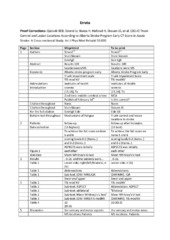| dc.contributor.author | Gjelsvik, Bente Elisabeth Bassøe | en_US |
| dc.contributor.author | Strand, Liv Inger | en_US |
| dc.contributor.author | Næss, Halvor | en_US |
| dc.contributor.author | Hofstad, Håkon | en_US |
| dc.contributor.author | Skouen, Jan Sture | en_US |
| dc.contributor.author | Eide, Geir Egil | en_US |
| dc.contributor.author | Smedal, Tori | en_US |
| dc.date.accessioned | 2014-12-03T10:05:15Z | |
| dc.date.available | 2014-12-03T10:05:15Z | |
| dc.date.issued | 2014-02-14 | eng |
| dc.identifier.issn | 2329-9096 | |
| dc.identifier.uri | https://hdl.handle.net/1956/8811 | |
| dc.description.abstract | Background: Stroke is a leading cause of disability in elderly people. Lesion location and size, and trunk control early after stroke have been found predictive of functional outcome. Trunk control is an important aspect of postural control, and commonly found to be impaired. A hemispheric difference in the regulation of postural control has been suggested, but limited knowledge of a relationship between specific lesions and trunk control exists. Objective: To explore the relationship between middle cerebral artery (MCA) lesion locations and trunk control post stroke, and compare trunk control between patients with lesions in single and multiple locations, and between left and right hemispheres. Methods: A cross-sectional design was used. Patients were recruited from a hospital stroke unit. Assessment tools: Trunk Impairment Scale–modified Norwegian version and Alberta Stroke Program Early CT Score (ASPECTS). Statistics: Descriptive, Independent t-test, Mann-Whitney’s U-test, Chi-Square test. Results:109 patients with first time middle cerebral artery lesions were included, 71 with multiple and 38 with single ASPECT locations. Trunk control was poorer in multiple (median 8.0) than in single (median 11.0) lesion locations, P=0.011. The most common single lesion locationswereM5 (50%) and internal capsule (18.4%). M5 is situated in the anterior parts of the MCA territory and hypothesized to represent sensory and motor areas of the cortex. Patients with lesions of M5 locations in the right hemisphere achieved poorer scores on trunk control than patients with left sided locations, P=0.030. Conclusions: The results indicate that patients with lesions in multiple ASPECT locations have poorer trunk control than patients with single locations, and that trunk control is poorer after single right M5 lesions as compared to left. We recommend therapists to have specific attention towards trunk control in rehabilitation of patients with MCA lesions and especially with a right M5 location early post stroke. | en_US |
| dc.language.iso | eng | eng |
| dc.publisher | OMICS Group | eng |
| dc.relation.ispartof | <a href="http://hdl.handle.net/1956/8815" target="blank">Trunk control in stroke. Aspects of measurement, relation to brain lesion, and change after rehabilitation</a> | eng |
| dc.rights | Attribution CC BY | eng |
| dc.rights.uri | http://creativecommons.org/licenses/by/3.0/ | eng |
| dc.title | Trunk Control and Lesion Locations According to Alberta Stroke Program Early CT Score in Acute Stroke: A Cross-Sectional Study | en_US |
| dc.type | Peer reviewed | |
| dc.type | Journal article | |
| dc.description.version | publishedVersion | en_US |
| dc.rights.holder | Copyright 2014 Gjelsvik BEB, et al. | |
| dc.source.articlenumber | 1 | |
| dc.identifier.doi | https://doi.org/10.4172/2329-9096.s3-001 | |
| dc.source.journal | International journal of physical medicine & rehabilitation | |
| dc.source.40 | S3 | |


